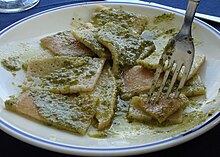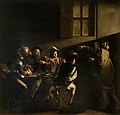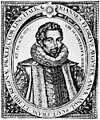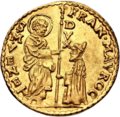The Italy portal
Italy Italian Republic , is a country in Southern and Western Europe . It consists of a peninsula that extends into the Mediterranean Sea , with the Alps on its northern land border, as well as nearly 800 islands , notably Sicily and Sardinia . Italy shares its borders with France, Switzerland, Austria, Slovenia, and two enclaves: Vatican City and San Marino . It is the tenth-largest country in Europe by area , covering 301,340 km2 (116,350 sq mi), and the third-most populous member state of the European Union , with a population of nearly 60 million. Italy's capital and largest city is Rome ; other major urban areas include Milan , Naples , Turin , Palermo , Bologna , Florence , Genoa , and Venice .
The history of Italy goes back to numerous Italic peoples , notably including the ancient Romans , who conquered the Mediterranean world during the Roman Republic and ruled it for centuries during the Roman Empire . With the spread of Christianity, Rome became the seat of the Catholic Church and the Papacy . Between late antiquity and the Early Middle Ages , Italy experienced the arrival of Germanic tribes and the fall of the Western Roman Empire . By the 11th century, Italian city-states and maritime republics expanded, bringing renewed prosperity through commerce and laying the groundwork for modern capitalism. The Italian Renaissance flourished during the 15th and 16th centuries and spread to the rest of Europe. Italian explorers discovered new routes to the Far East and the New World , contributing significantly to the European Age of Discovery . (Full article...
Vatican City Vatican City State (Italian : Stato della Città del Vaticano ; Latin : Status Civitatis Vaticanae ), is a landlocked sovereign country , city-state , microstate , and enclave surrounded by, and historically a part of, Rome, Italy . It became independent from Italy in 1929 with the Lateran Treaty , and is a distinct territory under "full ownership, exclusive dominion, and sovereign authority and jurisdiction" of the Holy See , which is itself a sovereign entity under international law , maintaining the city-state's temporal power , governance, diplomatic, and spiritual independence. The Vatican is also a metonym for the pope , the Holy See, and the Roman Curia .
With an area of 49 hectares (121 acres) and a population of about 764 (as of 2023), it is the smallest sovereign state in the world both by area and by population . It is also the second-least populated capital in the world. As governed by the Holy See, Vatican City State is an ecclesiastical or sacerdotal -monarchical state ruled by the Pope, who is the bishop of Rome and head of the Catholic Church . The highest state functionaries are all Catholic clergy of various origins. After the Avignon Papacy (1309–1377) the popes have mainly resided at the Apostolic Palace within what is now Vatican City, although at times residing instead in the Quirinal Palace in Rome or elsewhere. (Full article...
Testaroli testarolo pasta or bread in Italian cuisine that is prepared in circular sheets using water, flour and salt, which is then sliced into diamond or rectangular shapes. A common dish in the Lunigiana region and historical territory of Italy , it is an ancient pasta originating from the Etruscan civilization of Italy. Testaroli has been described as "the earliest recorded pasta". It is also a native dish of the southern Liguria and northern Tuscany regions of Italy.
Testaroli is prepared from a batter that is cooked on a hot flat surface, after which it may be consumed. It is traditionally cooked on a testo , a flat terracotta or cast iron cooking surface from which the food's name is derived. It is sometimes cooked further in boiling water and then served. Testaroli is sometimes referred to as a bread, and is sometimes referred to as a crêpe . It may be dressed with pesto sauce or other ingredients such as olive oil, pecorino , Parmesan , and garlic. Falsi testaroli al ragù is a similar dish, prepared using sliced pasta dough and a ragù sauce. (Full article...
Category puzzle Select [►] to view subcategories
The following are images from various Italy-related articles on Wikipedia.
Image 2 Pietà , by Michelangelo, is a key work of Italian Renaissance sculpture. (from
Culture of Italy )
Image 3 The Last Supper by
Leonardo da Vinci , possibly one of the most famous and iconic examples of
Italian art (from
Culture of Italy )
Image 4 Leonardo da Vinci , a
polymath of the
High Renaissance who was active as a painter,
draughtsman , engineer, scientist, theorist, sculptor, and architect (from
Culture of Italy )
Image 6 Federico Fellini , considered one of the most influential and widely revered
filmmakers in the history of cinema (from
Culture of Italy )
Image 10 Celebration of the 2777th
Natale di Roma at the
Circus Maximus (from
Culture of Italy )
Image 11 The
Venice Film Festival is the oldest film festival in the world. (from
Culture of Italy )
Image 12 Ferragosto fireworks display in Padua on 15 August 2010 (from
Culture of Italy )
Image 17 Florence Cathedral , which has the biggest brick dome in the world (from
Culture of Italy )
Image 18 Guglielmo Marconi was the inventor of
radio . (from
Culture of Italy )
Image 19 World map of first level subdivisions (states, counties, provinces, etc.) that are home to
Little Italys or Italian neighbourhoods (from
Culture of Italy )
Image 20 The
president of Italy Sergio Mattarella during his entry into the
Sala del Tricolore on the occasion of the
Tricolour Day on 7 January 2017 (from
Culture of Italy )
Image 22 Giosuè Carducci . In 1906, he became the first Italian to receive the
Nobel Prize in Literature . (from
Culture of Italy )
Image 23 Andrea Palladio is often described as the most influential
architect in the Western world. (from
Culture of Italy )
Image 24 Palazzo della Civiltà Italiana in Rome is a perfect example of modern Italian architecture. (from
Culture of Italy )
Image 25 Dario Fo , one of the most widely performed playwrights in modern theatre, received international acclaim for his highly
improvisational style. He was awarded the
Nobel Prize for Literature in 1997. (from
Culture of Italy )
Image 31 The cover of the
Corriere dei Piccoli on 11 July 1911 carries a cartoon strip in the Italian style, without speech bubbles. (from
Culture of Italy )
Image 33 The
Chamber of Deputies is the lower house of Italy. (from
Culture of Italy )
Image 34 Samantha Cristoforetti is the first Italian woman in space. She holds the record for the longest uninterrupted spaceflight by a European astronaut (199 days, 16 hours). (from
Culture of Italy )
Image 35 The historic seat of the
Corriere della Sera in via Solferino in Milan (from
Culture of Italy )
Image 36 The
Sagra dell'uva in Marino, Lazio, celebrating grapes (from
Culture of Italy )
Image 37 The
Jefferson Memorial in Washington, D.C. reflects the president's admiration for classical Roman aesthetics. (from
Culture of Italy )
Image 38 Palazzo Senatorio , seat of the municipality of Rome. It has been a
town hall since AD 1144, making it the oldest town hall in the world. (from
Culture of Italy )
Image 39 The
Frecce Tricolori , with the smoke trail representing the
national colours of Italy , above the
Victor Emmanuel II Monument in Rome during the celebrations of the
Festa della Repubblica on 2 June 2022 (from
Culture of Italy )
Image 41 Palazzo della Carovana, the current seat of the
Scuola Normale Superiore di Pisa (from
Culture of Italy )
Image 42 The
Azzurri in 2012. Football is the most popular sport in Italy. (from
Culture of Italy )
Image 43 William Shakespeare is an example of an Italophile of the 16th century. (from
Culture of Italy )
Image 45 Folkloristic reconstruction of the
Company of Death led by
Alberto da Giussano who is preparing to carry out the
charge during the
battle of Legnano at the
Palio di Legnano 2014 (from
Culture of Italy )
Image 46 Espresso is a coffee brewed by forcing a small amount of nearly boiling water under pressure through finely ground
coffee beans . The term
espresso comes from the Italian
esprimere , which means 'to express', and refers to the process by which hot water is forced under pressure through ground coffee. (from
Culture of Italy )
Image 47 Linguistic map of the
Italian language throughout the world
Official language
Secondary, widely spoken or understood
(from
Culture of Italy )
Image 49 Clockwise from top left:
Thomas Aquinas , proponent of natural theology and the Father of
Thomism ;
Giordano Bruno , one of the major scientific figures of the Western world;
Cesare Beccaria , considered the Father of criminal justice and modern criminal law; and
Maria Montessori , credited with the creation of the
Montessori education (from
Culture of Italy )
Image 50 Holographic copy of 1847 of "
Il Canto degli Italiani ", the Italian national anthem since 1946 (from
Culture of Italy )
Image 51 Royal Palace of Caserta is the largest former royal residence in the world. (from
Culture of Italy )
Image 52 A wooden puppet depicting the
Befana (from
Culture of Italy )
Image 54 Dante Alighieri , one of the greatest poets of the
Middle Ages . His epic poem
The Divine Comedy ranks among the finest works of
world literature . (from
Culture of Italy )
Image 55 Map of the
Italian diaspora in the world
Italy
+ 10,000,000
+ 1,000,000
+ 100,000
+ 10,000
(from
Culture of Italy )
Image 56 David , by
Michelangelo (
Accademia di Belle Arti , Florence, Italy), is a masterpiece of Renaissance and world art. (from
Culture of Italy )
Image 57 Sandro Botticelli ,
The Birth of Venus (
c. 1486 ).
Tempera on canvas. 172.5 cm × 278.9 cm (67.9 in × 109.6 in).
Uffizi , Florence. (from
Culture of Italy )
Image 58 Enrico Fermi , creator of the world's
first nuclear reactor . He is considered the "architect of the
nuclear age " and the "architect of the
atomic bomb ". (from
Culture of Italy )
Image 60 Scrovegni Chapel . The chapel contains a
fresco cycle by
Giotto , completed about 1305 and considered to be an important masterpiece of
Western art . (from
Culture of Italy )
Image 61 Giorgio Moroder , pioneer of
Italo disco and
electronic dance music , is known as the "Father of disco". (from
Culture of Italy )
Image 62 The
Uffizi in Florence (from
Culture of Italy )
Image 63 The
Forum of
Pompeii with
Vesuvius in the distance (from
Culture of Italy )
Image 67 Regional seat of
RAI in Cosenza (from
Culture of Italy )
Image 68 Entrance to
Cinecittà in Rome, the largest film studio in Europe (from
Culture of Italy )
Image 70 Leonardo da Vinci 's
Mona Lisa is an Italian art masterpiece worldwide famous. (from
Culture of Italy )
Image 72 The statue of
Italia turrita in Naples. Italia turrita is the
national personification of Italy. (from
Culture of Italy )
Image 73 The Italian explorer
Christopher Columbus leads an expedition to the
New World , 1492.
His voyages are celebrated as the discovery of the Americas from a European perspective, and they opened a
new era in the history of humankind and sustained contact between the two worlds. (from
Culture of Italy )
Image 74 Antonio Vivaldi , in 1723. His best-known work is a series of
violin concertos known as
The Four Seasons . (from
Culture of Italy )
Image 75 The
Altare della Patria in Rome, a
national symbol of Italy celebrating the first king of the unified country, and resting place of the
Italian Unknown Soldier since the end of World War I. It was inaugurated in 1911, on the occasion of the 50th
Anniversary of the Unification of Italy . (from
Culture of Italy )
Image 79 Starting in 1909, the
Giro d'Italia is the
Grands Tours ' second oldest. (from
Culture of Italy )
Image 80 John Florio is recognised as the most important Renaissance humanist in England. (from
Culture of Italy )
Image 81 The
Colosseum , originally known as the Flavian Amphitheatre, is an elliptical amphitheatre in the centre of the city of Rome, the largest ever built in the
Roman Empire . (from
Culture of Italy )
Image 82 Ernesto Teodoro Moneta was awarded the
Nobel Prize for Peace in 1907. He adopted the motto
In varietate unitas! which later inspired
Motto of the European Union . (from
Culture of Italy )
Image 83 Alessandro Manzoni is famous for the novel
The Betrothed (1827), generally ranked among the masterpieces of world literature. (from
Culture of Italy )
Image 84 Augustus created during the
Roman Empire for the first time an administrative region
called Italia with inhabitants called
Italicus Populus ; for this reason historians called him
Father of Italians . (from
Culture of Italy )
Image 85 Gelato is Italian ice cream. (from
Culture of Italy )
Image 86 Romulus and Remus , the
Lupercal ,
Father Tiber , and the
Palatine on a
relief from a pedestal dating to the reign of
Trajan (AD 98–117) (from
Culture of Italy )
Image 87 Luciano Pavarotti , considered one of the finest tenors of the 20th century and the "King of the
High Cs " (from
Culture of Italy )
Image 88 Teatro di San Carlo , Naples. It is the oldest continuously active venue for opera in the world. (from
Culture of Italy )
Image 90 Anti-fascist demonstration at
Porta San Paolo in
Rome on the occasion of the
Liberation Day on 25 April 2013 (from
Culture of Italy )
Image 91 The Creation of Adam is one of the scenes on the ceiling of the
Sistine Chapel of the Vatican, painted by
Michelangelo sometime between 1508 and 1512. (from
Culture of Italy )
Image 92 Milan Cathedral is the
fourth-largest church in the world. (from
Culture of Italy )
Image 93 The ingredients of traditional
pizza Margherita —
tomatoes (red),
mozzarella (white), and
basil (green)—are inspired by the colours of the national
flag of Italy . (from
Culture of Italy )
Image 94 The
Roman Empire provided an inspiration for the medieval European. Although the
Holy Roman Empire rarely acquired a serious geopolitical reality, it possessed great symbolic significance. (from
Culture of Italy )
Image 95 Antonio Meucci , inventor of the first
telephone (from
Culture of Italy )
Articles related to Italy
Astronomical observatories in Italy
Automobile museums in Italy
Central bank Public banks Global banks Nationwide and Multi-regional Multi-regional and Co-operative banks (BCC) Regional retail bank others Foreign banks Ancient banks Related topics
Historical minority communities Ethno-linguistic minorities Scattered minorities Immigrants and expatriates
Europe Africa Asia Americas and Australia
Historic currency and coinage of Italy
Overview Ancient Medieval Modern Contemporary
Africa Americas Asia Europe Oceania Exodus Neighborhoods
1890s-1950s 1960s-1980s Other
Historical linguistic minorities :
Albanian ,
Catalan ,
Croatian ,
French ,
Franco-Provençal ,
Friulian ,
Germanic ,
Greek ,
Ladin ,
Occitan ,
Romani ,
Sardinian ,
Slovene ,
Wenzhounese
^ Venetian is either grouped with the rest of the Italo-Dalmatian or the Gallo-Italic languages, depending on the linguist.
National Regional/local Financial Sports Free On-line
Resources in Italy
Oil Natural gas
Kingdom of Sardinia (1720–1861)
Prima Triennale Pubblica Esposizione dell’anno (1829)
Seconda Triennale Pubblica Esposizione dell’anno (1832)
Pubblica esposizione dell'anno (1838)
Quarto Esposizione d'Industria et di Belle Arti (1844)
Esposizione dei Prodotti e delle Manufatture nazionale (1846)
Quinta Esposizione di Industria e di Belle Arti (1850)
Esposizione Industriale (1854)
Sesta Esposizione Nazionale di Prodotti d'Industria Kingdom of the Two Sicilies (1808–1861)
Solenne Pubblica Esposizione di Arti e Manifatture (1853) Kingdom of Italy (1861–1946)Italy (1946 - present)









































































































































